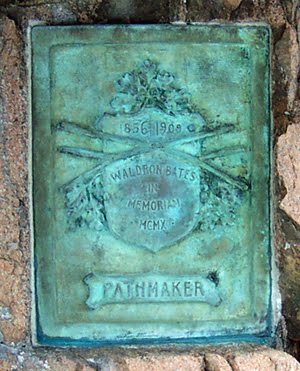Atwater Kent - Inventor, Industrialist and
Philanthropist
The previous blog post, “Memorial Maintenance,”
mentioned the recently refurbished Atwater Kent memorial. It was installed in
1946 on the Schooner Head Path, south of downtown Bar Harbor, ME and just
beyond High Seas, the former home of pathmaker
and Princeton professor, Rudolph Brunnow.*1
 |
| Kent memorial - Champlain Mountain background |
The inscription on the bronze plaque reads:
ATWATER KENT FIELD
ATWATER KENT FIELD
OF APPROXIMATELY 62 ACRES
WAS DONATED IN 1946 BY THE
ATWATER KENT FOUNDATION
TO THE UNITED STATES OF
AMERICA
AS A PART OF
ACADIA NATIONAL PARK
 |
Library of Congress
A. Atwater Kent
|
Arthur Atwater Kent (1873-1949), an
entrepreneur, industrialist and philanthropist, was born in Burlington, VT. He made his fortune by inventing the
automatic ignition for automobiles and afterwards establishing the country’s
biggest radio manufacturing business which, starting in 1923, produced the
popular, eponymously named radio. He closed the Philadelphia-based business in 1936
and retired to Bel Air, CA.
In 1946 the Atwater Kent Foundation
gave Acadia National Park 62 acres off Schooner Head Road. That same year, the
Atwater Kent Properties Corporation sold 210 acres for $21,500 to the U.S.
Government which was to be designated as the “Atwater Kent Field.” This
property ran north-south from the High
Seas estate to Schooner Head and east-west from the coast to Champlain Mountain.
While a summer resident of Bar
Harbor, Kent owned the former Frederick Vanderbilt’s estate, Sonogee, and the Robert Abbe estate, Brookend, off Eden Street on the north and
south sides of Duck Brook, respectively. Among his other holdings were Long
Porcupine and The Hop, two islands off Bar Harbor in Frenchman Bay.
 |
Find A Grave
Kent grave
|
Kent died in 1949 at his Bel Air
home and was buried at Forest Lawn Memorial Park in nearby Glendale. In his
will, he left $1.3 million to charities and educational institutions.
*Footnote:
1 GPS coordinates of
the Kent memorial: N44° 21.083' W068° 10.995'








